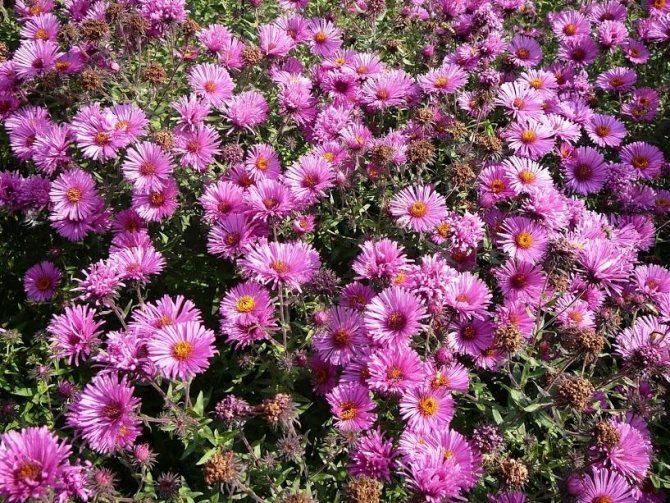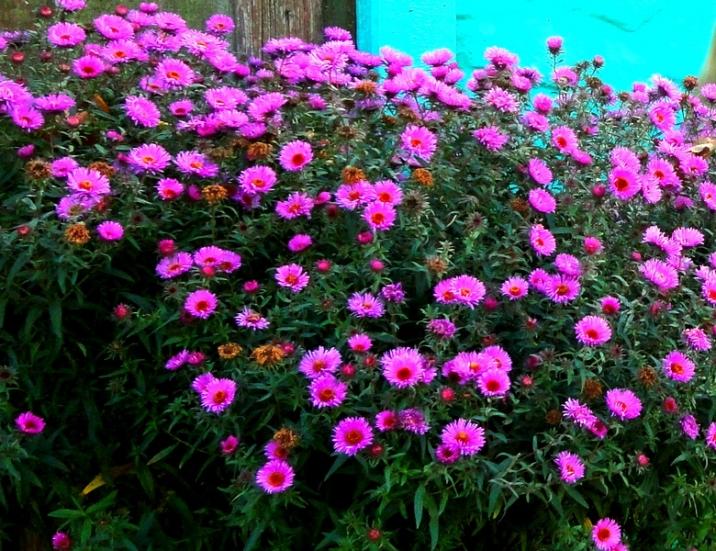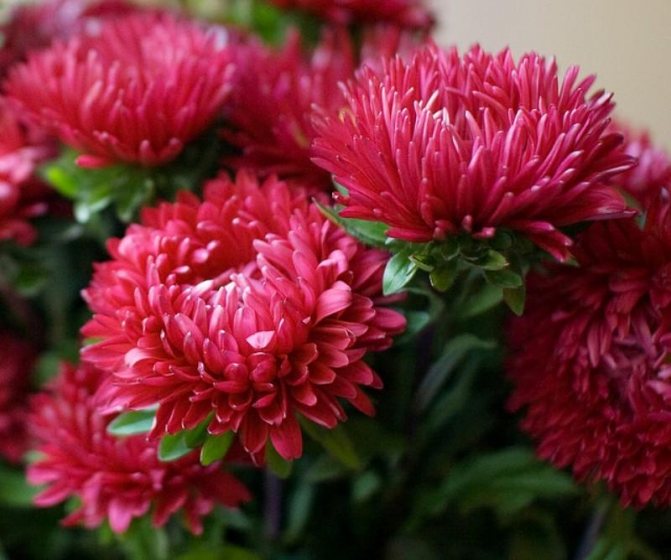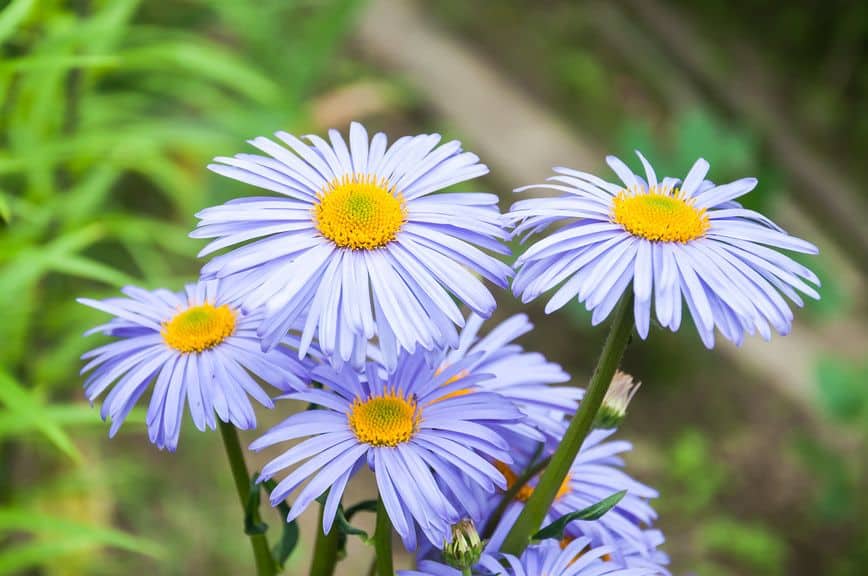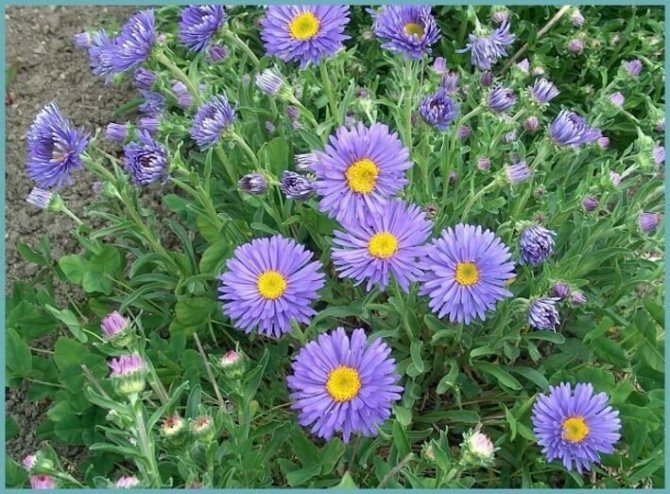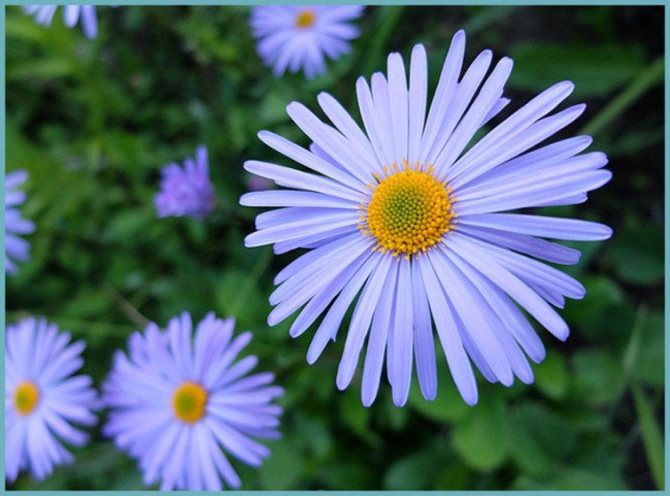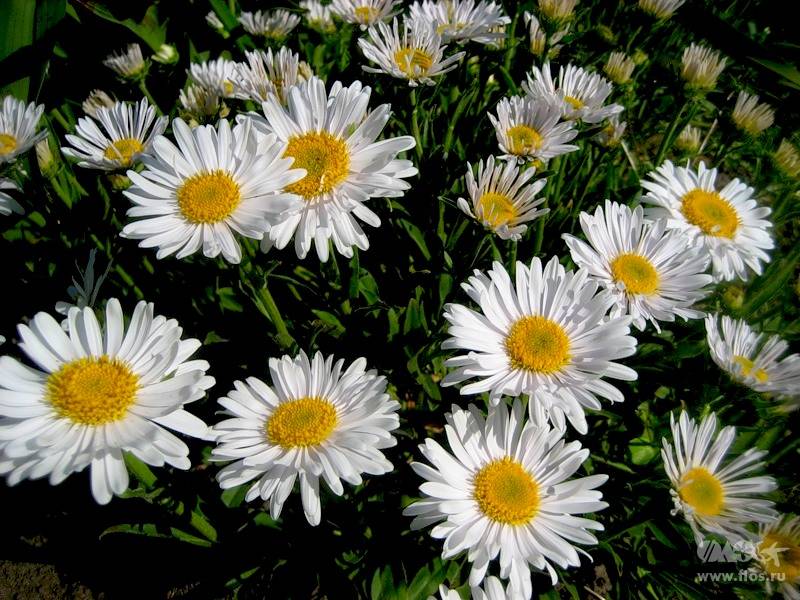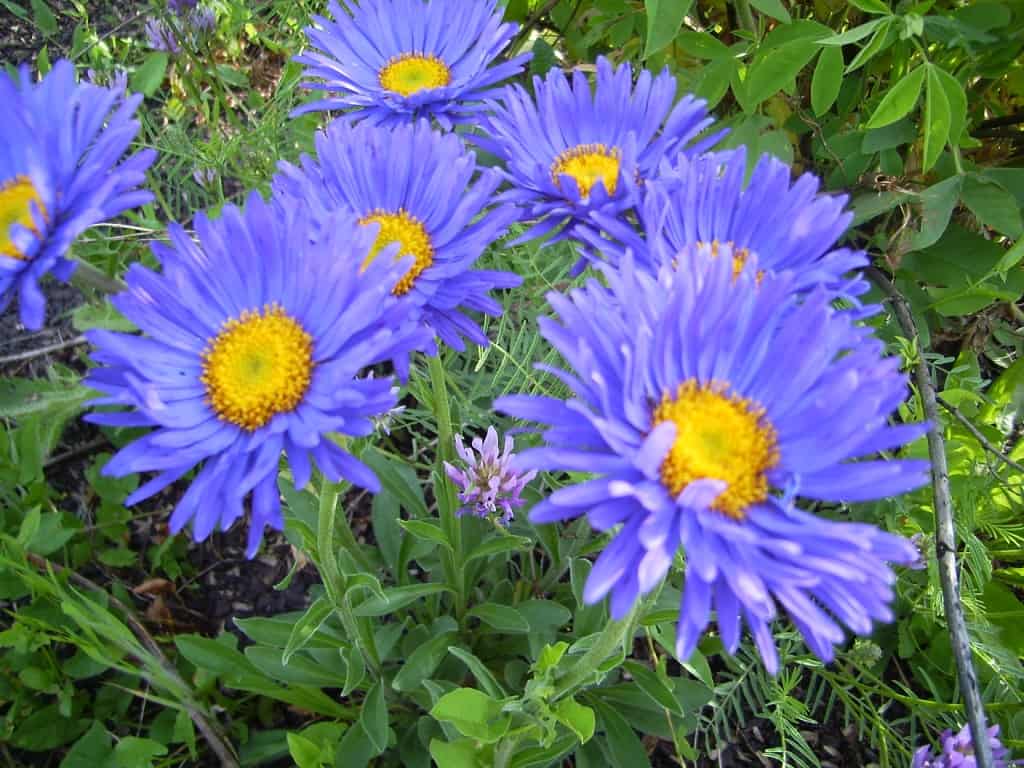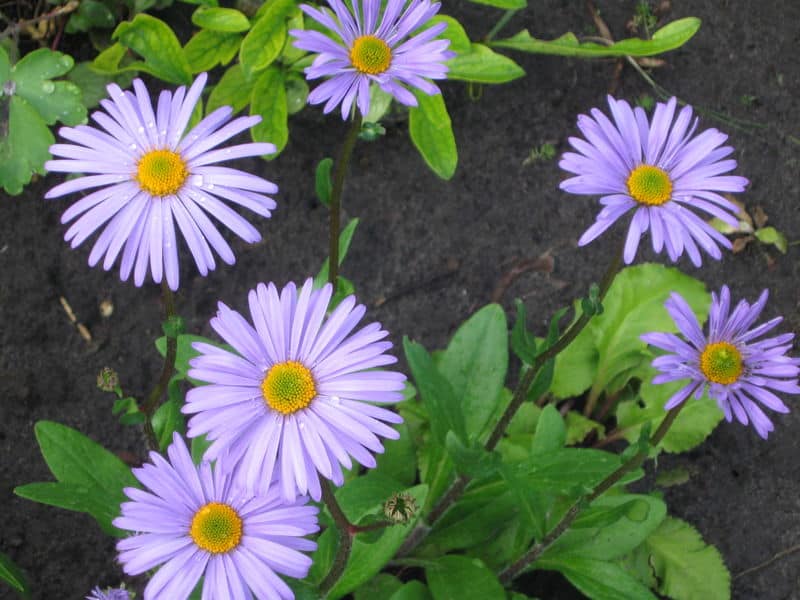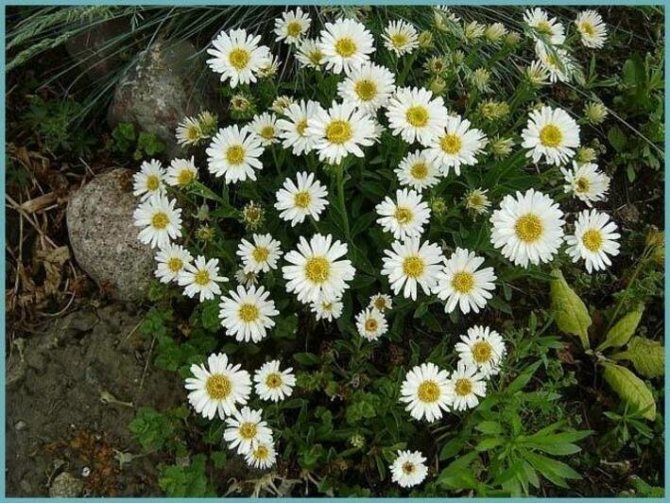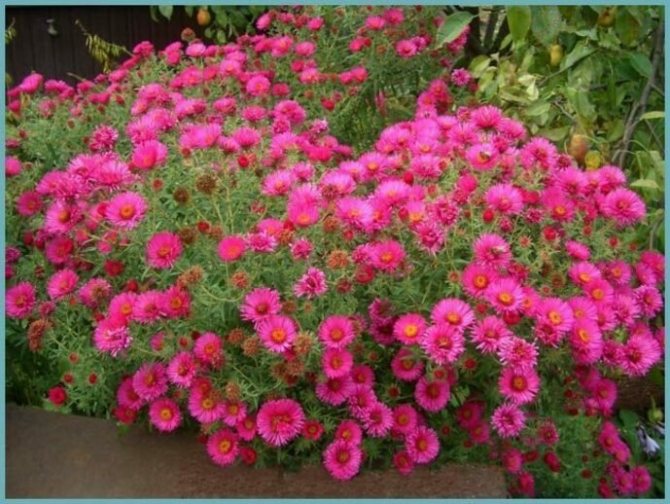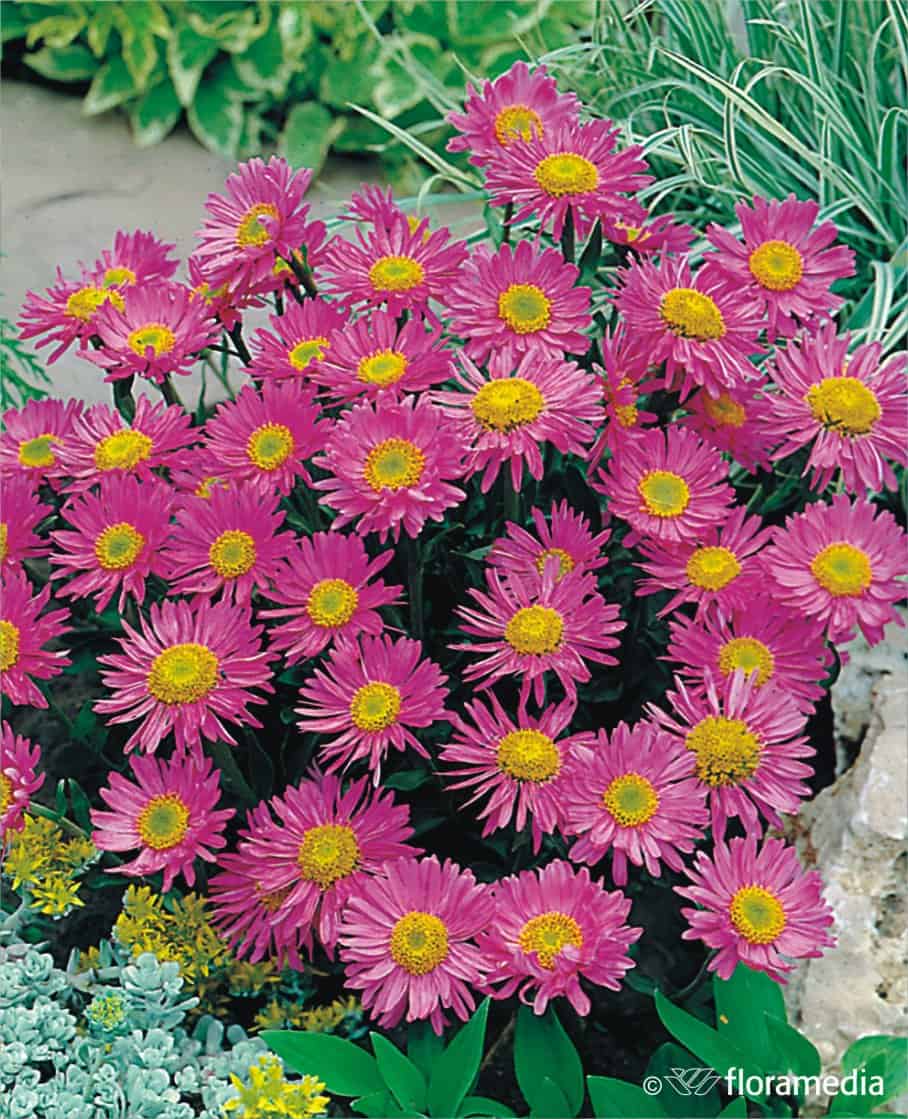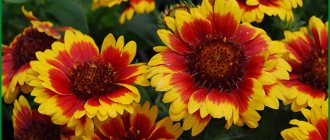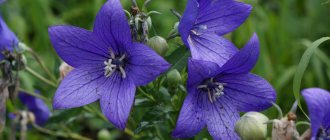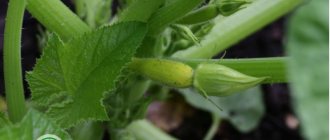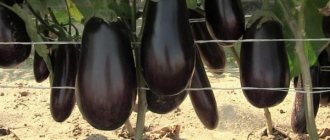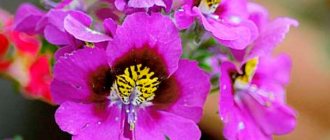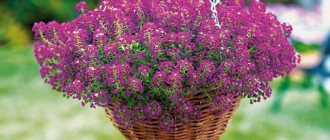- Aster annual
- How to grow an annual aster from seeds
- Perennial aster
- Which variety of asters to choose
Description of the perennial aster
Aster is a plant loved by many gardeners. Shoots of a herbaceous perennial erect with dense foliage. Stem height ranges from 30 cm to 2 m. Leaves are bright green. They are small, lanceolate. The inflorescence is a small basket. In appearance, they are very similar to small bright stars. They come in different shades:
- white;
- blue;
- purple;
- pink;
- crimson.

Perennial aster
Description and characteristics
Perennial bush aster belongs to the family Astrovye or Compositae. It is this plant that is the true aster, while the more famous annuals belong to a completely different family of flowers (Calli-stefus).
In nature, perennial asters can be found in Europe and Asia, in North Africa and North America. Ornamental shrubs were grown in flower beds due to their late flowering and suitability for cutting: in the autumn garden, perennial aster is one of the few bright spots.


Shrub asters can be recognized by the following features:
- herbaceous rhizome plant;
- aster stems are straight, branched;
- the height of the bush can vary from 25 to 160 cm;
- leaves of a dark green hue, have a lanceolate shape;
- the size of the leaf blades gradually decreases towards the top of the stem;
- bush aster inflorescences - baskets, the diameter of which can be from 1 to 7 cm;
- the edges of the inflorescence are ligulate, and in the middle of the aster there are yellow tubular petals;
- shades of asters can be very different: white, pink, blue, purple, burgundy and others;
- the structure of the flower is simple, semi-double or double;
- flowering of this plant is long - about 35-40 days;
- bush varieties are photophilous, do not tolerate extreme heat and drought;
- the plant is unpretentious to the composition of the soil, grows well on heavy and clayey soils (aster shows itself best on humus soil);
- perennials perfectly tolerate frosts, so they can winter in the middle lane without shelter;
- every 5-6 years, aster bushes need to be separated and planted;
- flowers reproduce by seeds and division.
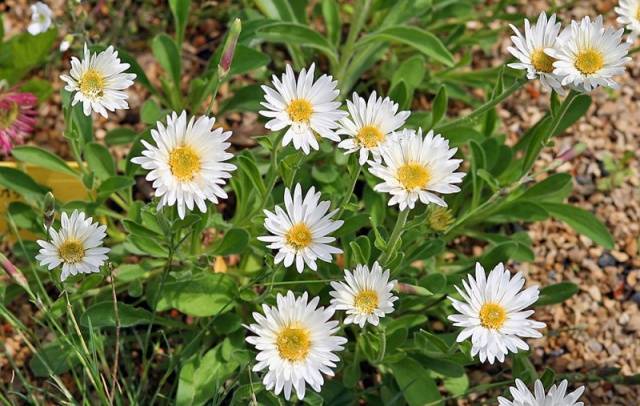

Description of the types of perennial varieties of Asters
Perennial evening primrose (flower): planting and care
A huge number of garden perennial asters are known.
Bush
This rather compact bush grows up to 60 cm. The seed ripens in October. Aster bush frost-resistant. However, a few years later, when a small hummock is formed above the ground from new shoots, perennial bush asters can freeze out in winter.
Undersized
The shrub does not exceed 40 cm. The tops of the undersized perennial aster are decorated with many small stars. In diameter, they are most often up to 3-3.5 cm. The flowering period is September. Against the background of withering greenery, such a bright low flower bed looks impressively summer-like.


Bush aster
Autumn
The flowering period is September-October.In Russia, autumn asters are often called santbrinks. However, in some cold years, even the most caring owners may not see the flowers of the plant. In height, perennial autumn aster can reach both 30 cm and 1 m.
Winter
This is the most persistent type of perennial asters. Inflorescences survive until the first snow. They are also called Octobrinks. There is also a problem with winter asters, as well as with autumn ones - sometimes they do not have time to dissolve the buds.
Spherical
This species has earned its name due to the ideal shape of the bush. The average height of a spherical aster is 50 cm. The flowers are small, but there are many of them, which creates the illusion of a ball during the flowering period.
Spherical aster
Alpine
This type of flower is frost-resistant. After planting, the first flowering can be observed the next year from the end of May to mid-June. This is a low-growing variety of asters. The height does not exceed 25 cm, and the blossoming bud grows up to 6-8 cm.
Austrian
This species reaches a height of 80 to 1.5 m. The flowering period of the Austrian beauty is September. They are frost-resistant. The flowers are like daisies, 6 cm in diameter.
Italian
The bushes of the Italian perennial spherical aster. They grow by 60 cm. The flowering period of this species is mid-summer, namely July August. A small bush becomes covered with flowers, similar to daisies. The only difference is the dark purple color. They are collected in tight sockets. The diameter of each flower does not exceed 5 cm. Among the Italian asters, there are many varieties. At the same time, I would like to pay special attention to the Bessarabian one. This is the largest representative of this species. Its height reaches 75-80 cm. The color of the petals is bright purple and pale pink. The core is brown.
Important! The seeds of the Italian aster ripen by the beginning of September.
English
This species is distinguished by its dense and bright flowering. Inflorescences are blue, marsal, salmon, white, purple, blue, pink. In height, English asters reach up to 2 meters. Therefore, this species is loved by gardeners for the opportunity to decorate the foot of garden trees with small flowers with a diameter of 3 cm.
Others
Golden aster will delight in the last summer month with its bright flowers in the form of cones. On long and strong shoots, 10 to 20 buds develop.
Bokotsvetnaya deserves special attention. Its shoots develop in the form of a vine. They are often white with a slight shade of pink. By the end of the flowering period, they turn bright purple.
American aster will delight the owner with abundant flowering, which lasts all summer.
Alpine aster: combination with other plants
Alpine aster blooms for quite a long time, it is she who can serve as a background for other flowers, gradually replacing each other from spring to autumn.


Asters of different colors can look great on a flower bed.
Border irises, cypress euphorbia, evening primrose, multicolor euphorbia, spotted loosestrife, which are painted in bright yellow, look spectacular against the background of purple asters. The combination of bearded irises and alpine asters looks interesting - by planting blue or lilac varieties next to it, you can create an eye-pleasing composition by playing on a smooth change of halftones.
Astra goes well with:
- violets;
- geraniums;
- stonecrop large;
- stonecrop prominent;
- white dogwood;
- badan;
- Thunberg barberries;
- spiria Japanese.


Alpine aster on a flower bed
Experienced gardeners willingly include Julia's primrose, reed grass, spartina, creeping thyme in a composition with alpine aster. Ornamental cereals are good partners for perennial asters.
Most popular varieties
Aster dumosus starlight
Aster shrub Starlight (starlight) is a low compact plant. Its inflorescences grow up to 4 cm in diameter, bright pink in color.An adult perennial shrub aster resembles a ball about 40 cm high. Flowering is abundant and lasts from September until the first frost.
Aster dumosus kristina
Aster dumosus kristina is white cushion with a bright yellow core. An adult flower grows to 30-40 cm. It blooms in August-September.
Others
New Belgian: Bitchwood Rivell (purple), Dick Bayllard (pink), Saturn (sky blue), Amethyst (purple), Octouberfest (terry blue aster).
English: Lillith Fardel (pink aster), Dr. Eckerner (red-violet), Brownman (lilac), Rote Stern (burgundy).
Alpine asters: Dunkle Sean, Alba, Ruper, Gloria. Dwarf varieties harmoniously decorate border areas and small flower beds.
Plant propagation
Alpine aster propagation is carried out in two ways: by seeds and by dividing a bush that has been growing for a couple of years.
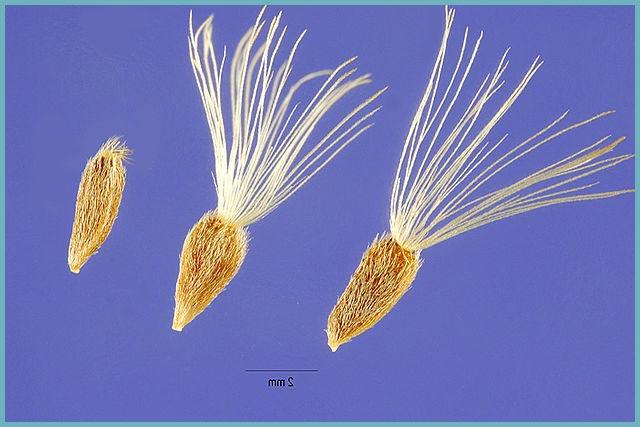

Aster seeds
Seeds asters are harvested at the end of autumn after flowering, planted in fertilized soil and covered with a film to obtain a greenhouse effect. The received seedlings dive in March-April, after the appearance of the first leaves. Asters grown from seeds bloom in the open field only in the second year. This method of reproduction is quite laborious, since the germination of seeds is low.
Dividing the aster bush (vegetative method) - a simple and quick method of propagation and planting new areas with flowers. It is necessary to separate part of the bush together with the rhizome in the spring after the beginning of rapid growth, remove weak stems and transplant to a new place.
Advice. Aster can grow in one place for up to 7 years, but in order to renew the bush, maintain lush flowering, it is recommended to replant the culture every three years.
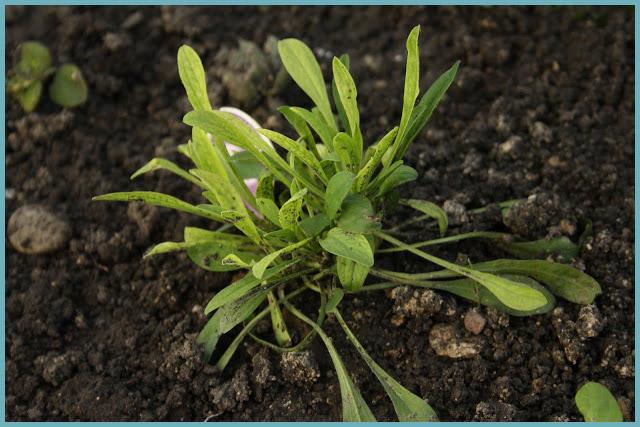

Alpine aster tolerates bush division quite well
Also asters all summer can be propagate by cuttings... The tops of the shoots are suitable for this, their recommended length is about 6 cm. Cuttings should be planted in specially prepared beds with special soil (turf soil, peat, sand in the ratio of 2 parts of land to 1 part of peat and 1 part of sand) in partial shade, covered with agrofiber. Rooting time for cuttings is about 1 month. As cuttings, you can use young shoots up to 15 cm tall, cut into several parts, each of which should have 3 leaves. In August-September, such cuttings can be planted in a permanent place of growth.
How perennial asters breed
These flowers are rarely propagated by seed.
Important! The problem is that they quickly lose germination properties. For this flower, it is preferable to use vegetative methods.
Dividing the bush
For reproduction in this way, it is recommended to wait for the period when the flower grows 3-5 cm from the ground. Next, the bush is divided into small parts with 2-3 buds and planted. The next year, the delenki form a full-fledged plant. The division is best done every 3-4 years. This helps to rejuvenate the root system and also prevents the development of fungus.
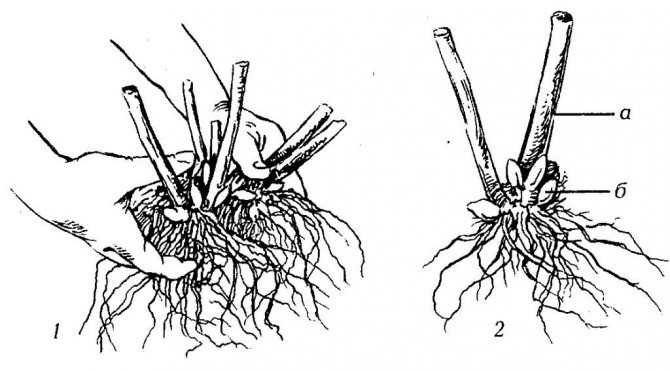

Dividing the bush
Cuttings
For reproduction in this way, you can use both the top and the whole stem. For rooting, it is recommended to select areas with loose soil in a shady area. The stalk is rooted in the ground and covered with foil. There are no strict time limits. The procedure can be carried out throughout the summer.
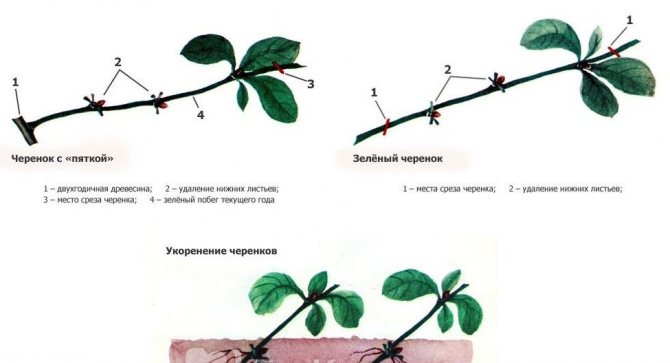

Cuttings
How to care for flowers?
Simple actions are required during the growth of flowers: watering, feeding, fighting diseases, pests.
Watering and humidity
In a hot summer, New England aster is watered abundantly. The procedure is carried out after sunset. Pour 3 buckets of water under each bush. Watering is also required at the time of budding.
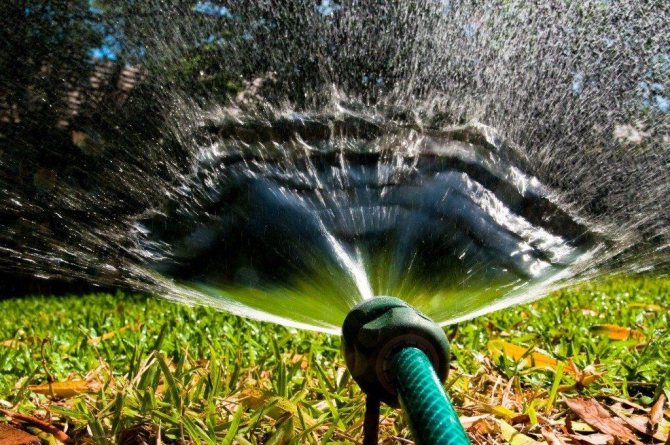

Watering frequency depends on air humidity. The higher the humidity, the less watering. After watering, the soil is loosened.Just keep in mind that the roots are located close to the surface, so you can't go deeper than 5 centimeters.
The soil
Astra needs a nutritious soil with a neutral reaction. If the soil is acidic, add dolomite flour or lime.
Top dressing
New England aster responds well to feeding.
- First feeding. Mineral fertilizer is applied when 4 leaves appear.
- Second feeding. At the time of budding, complex fertilizers are applied.
- Third feeding. During active flowering, potassium-phosphorus fertilizer is applied.
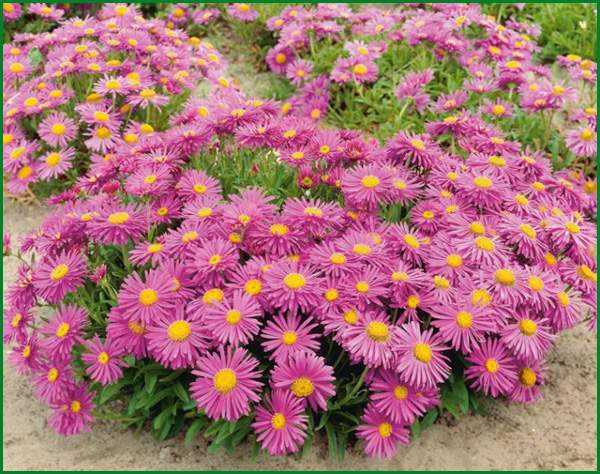

Temperature
New England aster tolerates drought well. You will not see the plant drooping. Only the lower leaves will turn yellow. It also withstands autumn frosts up to 8 degrees.
Winter care
Winter hardiness is the main characteristic of the New Belgian asters. But even they will not stand frosts above 40 degrees. In harsh climatic conditions, the bushes are insulated for the winter. To do this, cut the stems so that there are hemp. Lay the leaves, humus on top.
Features of home care
Aster is a street plant. However, its seedlings can also be found in the homes of experienced gardeners. To grow a strong and healthy plant, you must adhere to the basic recommendations.
Temperature
For active growth and development of seedlings, it is recommended to maintain a temperature of 15-16 degrees. As 3-4 leaves appear at the first shoots, the temperature can be reduced to 12-15 degrees.
Important! To make the flowers feel as comfortable as possible after being transplanted outside, it is recommended to lower the temperature in the room at night. This will allow the seedlings to adapt as quickly as possible to new outdoor conditions.
Lighting
Astra loves to bask in the warm rays of the sun. Seedlings are recommended to be placed on a windowsill on the sunny side. If this is not possible, it is recommended to install lamps nearby. Many growers put the seedling containers in the greenhouse for a while. This allows them to spend extra time in the sun, and it is also useful as a hardening of the sprouts.
Watering
Watering should be abundant, but rare. After each moistening of the soil, it is recommended to loosen it carefully. This will avoid waterlogging of the soil. Do not allow the soil to dry out.
Spraying
Spraying is an essential step in growing healthy flowers. The first week after the appearance of the first shoots, the soil is moistened with a spray bottle once a day. The second week - once every two days. In the third week, you can start full watering 2-3 times a week, gradually reducing the frequency, but increasing the volume of liquid.
Humidity
The recommended air humidity in the room where the asters grow should not fall below 65%. The maximum value is 80%.
Priming
Aster is a flower that prefers fresh soil. This is due to the fact that the old soil can contain sources of various diseases and pests. Ideal mixture for a flower: sand, turf, decomposed peat. The components are mixed in a 1: 3: 1 ratio. All large lumps must be removed from the soil.
Important! For seedlings, ordinary river sand is suitable, but if you cannot get it, then you can use coarse-grained, having previously calcined it.
Top dressing
To grow strong flowers indoors, you need to consider feeding. The first feeding is recommended 2 weeks after planting the seeds. It is during this period that the root system is actively developing. For the first time, it is recommended to mix potash and phosphate fertilizers, while the proportion should be 2 times less than that indicated in the instructions. It is necessary to apply top dressing directly to the soil. If it gets on tender young leaves, burns may occur.
Alpine aster in landscape design
Since perennial alpine aster is rather unpretentious in cultivation, it is actively used in landscape design, gardeners and simply lovers of wildlife in flower beds, rock gardens, in the design of flower beds, rocky hills, as a balcony plant.
It is recommended to plant alpine asters in the foreground of shrub plantings, in curbs, to decorate the banks of small garden or summer cottages.
Aster alpine perennial is equally loved by experienced landscape designers and amateur gardeners. It is easy to care for, does not require special watering conditions, but at the same time it pleases with bright colors almost the whole summer, emphasizing the beauty of the surrounding nature. Pay attention to the Alpine aster, and she will thank you with exuberant flowering.
Planting perennial asters: video
Alpine aster: photo
When and how it blooms
Today, botanists know a huge number of species, varieties and hybrids of this unusually beautiful flower.
Types of flowers
The Aster family includes a huge number of flower species. Choosing a plant that is suitable for a particular installation or flower bed will not be a problem. Today, there are several main and most popular types:
- ostrich feather;
- duchess;
- bouquet;
- Victoria.
Flower shapes
Asters are divided into several groups according to their shape.
To size:
- small - up to 3.5-4 cm;
- medium - from 4 to 8 cm;
- large - from 8 cm.


Inflorescence shapes
By the shape of the inflorescence:
- flat;
- rounded flat;
- hemispherical;
- spherical;
- semi-double;
- terry.
Flowering period
Typically, asters are divided into 3 flowering periods. The first ones are spring. Blossom from May to June. Next comes the turn of the summer. They bloom from June to August. Perhaps this is the longest group of flowers. Autumn delights from the end of August until the first snow.
Changes in care during flowering
During the budding process, the aster is fed a second time. For this, prepare 50 gr. a mixture of phosphate and potassium for each 1 m2 of land. Just before the beginning of flowering, the aster is fed a third time. The composition of the top dressing remains the same. When the flowers are in full bloom, it is recommended that you reduce the watering a little. Asters are very sensitive to excess moisture, but do not overdry the soil too much. The frequency of watering is recommended to be developed independently, based on the time of complete drying of the soil near the root system.
Important! If the summer is dry, then watering should be abundant. Otherwise, the flowers will be scarce and small.
Transplant after purchase and during reproduction
It is recommended to transplant seedlings into open ground in early May. It is recommended to loosen the soil after each watering or rain. This helps to ventilate the root system and protects against rotting.
If the time for planting seedlings is missed, then you can resort to the cuttings method, which can be carried out throughout the summer.
Planting a plant
Before planting a plant in open ground, you must choose a suitable location: all perennial asters love a well-lit, sunny place. It is recommended to fertilize the soil before planting asters (phosphate preparations are used), dig up, select all weeds and moisten.


Astra does not need any special care, only watering, loosening and a well-chosen place for planting
It is advisable to add about 200 g of lime to the soil before digging the soil and planting asters (you can replace it with dolomite flour), about 100 g of superphosphate. It should be dug up to a depth of 30 cm.
Attention! Damp, flooded soils are categorically unsuitable for planting asters. In such conditions, the plant becomes infected with powdery mildew and simply dies.
Possible growing problems
An attentive gardener immediately sees external changes in his favorite flower.
Leaf problems
If the leaves began to turn yellow, turn brown, curl and dry out, then this signals improper care or the development of the disease.
First of all, you need to make sure that the flower is not overdried. You can try to change the mode of soil moisture. If black longitudinal stripes are added to the listed factors, then this indicates the development of fusarium. This disease appears if the soil was excessively moistened, and stagnant water was observed in the root system. In this case, it is impossible to save the plant.
The appearance of tuberous spots also indicates the development of late blight. To overcome the disease, it is necessary to cut off all affected areas and sprinkle with activated carbon
Pests
Aphids, thrips and cicadas are the main pests for asters. They suck the sap from the plant and are disease carriers. In order to prevent the appearance and reproduction of insects, it is necessary to treat the flowers with Fitoverm solution or other insecticides.
The earwig is able to gnaw not only the leaves of the flower, but also the stems and buds. To drive away the insect, you need to regularly remove weeds and loosen the soil.
Important! When the first signs of a spider mite are found, the leaves and stems of the plant are recommended to be treated with soapy water.
Diseases
Mosaic disease manifests itself as yellow streaks on the leaves. After that, chlorosis develops, and the plant stops developing. To overcome this disease, it is recommended to treat the bush with Aktelik or Peritrum.
Aster rust is a fungus native to pine needles. The disease is characterized by the appearance of swellings on the lower part of the leaves. They are filled with rusty spores. For treatment, use a 1% solution of Bordeaux liquid. Processing is carried out after 10 days. If the disease is detected late, then the bush is almost impossible to save.
Signs of improper care
Astra, although an unpretentious plant, will nevertheless immediately tell its owner about improper care. First of all, the leaves of the plant signal this. They can fade or change color. If you do not take action on time, then improper care will affect flowering. The inflorescences will be scanty and pale. In addition, the plant will have few flowers.


Aster
Many different types of asters have been bred. Before buying a particular variety, it is recommended that you familiarize yourself with the description of the flower in more detail. General principles and rules may sometimes not apply to individual hybrids. If the flower bed is constantly being updated, then it is recommended to pay attention to annual varieties.
Treatment from pests, diseases
In the fight against fusarium, a solution with potassium permanganate is used. The seeds are soaked for 3 minutes and washed under water. If a bush is affected, all affected areas are removed and burned. Healthy asters are sprayed with Fundazol.
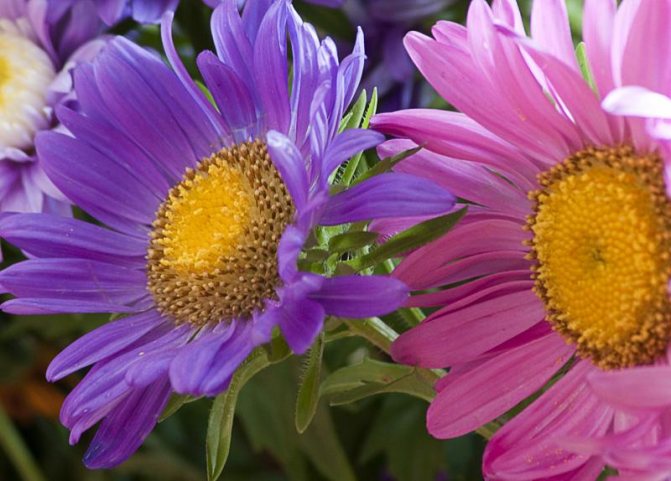

Powdery mildew, gray rot affect perennials in the summer. Reasons: rainy weather, overflow. The bushes are treated with Topaz. Spider mites and aphids are attacking the Novobelgiskaya aster. The bushes are sprayed with a drug that is harmless to bees, but deadly for pests - Aktofit.
Watering
Despite the fact that this flower crop is especially resistant to drought, watering is necessary for it.
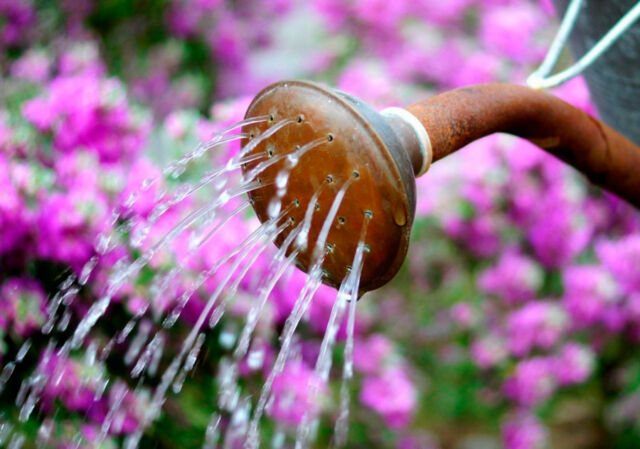

Watering should be done sparingly, as the soil dries. On average, in moderately hot weather, once every 5 - 7 days is enough. The planting site should not be near groundwater, otherwise, because of this, rotting of the root system may begin. Which will have a detrimental effect on the plant as a whole.
The water should not be cold. She needs to settle down. Rainwater works well. To do this, you can put empty barrels on the site, where water will be collected during rain.
If summer is accompanied by high temperatures, mulch the soil to help retain moisture. For this, sawdust or straw are perfect.
Particular attention should be paid to it during the period of inflorescence formation, otherwise you may be left without lush, bright bushes.
Flower variety
Asters flowers are unique, because there are so many of them - tall, stunted, perennial, annual. In turn, the latter are divided into three main classes, which were formed in terms of decorativeness and structure - reed, tubular, transitional. These three classes are further divided into 10 according to the type of flower, its shape. Each group has its own varieties that can surprise the most fastidious gardeners, take a look at the photo - this is a pompon aster. The charm of these balls is striking, while they can also have different shades, but these are one-year-olds. And today we are talking about perennial species, and we will consider them further.
General characteristics
The New England Astra became known back in the 1700s, and its homeland is the center and east of North America. From here came another name for this type of aster - American. She herself presents decorative herbaceous plants for open ground with beautiful flowers. The perennial bush belongs to the Aster family, the genus Symfiotrichum. On average, the height of the bushes varies from 0.5 to 2 meters. In girth, plants of this species can reach 0.5-0.8 meters. It is worth noting that the aster of this species is branched, fluffs are located on the entire surface of its straight stem. On one bush, the number of flowers can reach 150-200 pieces.
On each stem there are oblong lanceolate leaves and inflorescences in the form of baskets with a diameter of 3 centimeters. One inflorescence can contain up to 25-30 baskets, which are small reed and tubular flowers. Various colors of asters include pink, carmine, reddish, purple, blue, violet and yellow hues. Flowering time is the entire autumn period. Many varieties are able to withstand frosts down to minus 5 degrees. Gardeners love that flowering times vary slightly from variety to variety. Planting representatives of the New England aster is best in fertile land that is open to sunlight.
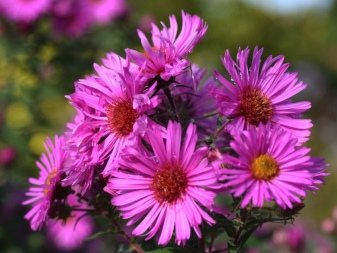

It is best to take the end of spring or the first month of autumn for a transplant. The division of the bushes must be carried out every 3 years. As for reproduction, it is carried out both by division and by cuttings.
Garden aster care
How to care for aster
Any experienced florist to the question: "How to grow asters?" will answer that it is very easy. Asters are unpretentious, and caring for them does not require much time and effort. The first rule of caring for asters - mandatory loosening of the soil with simultaneous weeding. This must be done after each rain or watering to a depth of 4-6 cm, no more. Even before branching, huddle the stem to a height of 6-8 cm in order to accelerate root growth.
We grow daisies - choose the type for yourself
- Gladiolus - landing and care
When watering asters, remember that both lack and excess of moisture harm them. In a hot summer, water less often, but more abundantly (up to 3 buckets of water per 1 m²), with the obligatory subsequent loosening. You will be late with watering - the inflorescences may lose their decorative effect.


In the photo: White asters
If you want to get the most out of your asters, do not forget to feed them. During the season, there should be at least three fertilizing: the first time - a week or two after planting (20 g of ammonium nitrate, 10 g of potassium sulfate, 50 g of superphosphate per m²), when the buds appear, you need to feed the asters a second time (50 g of potassium sulfate and superphosphate per 1 m²) and the third (the same composition) at the very beginning of flowering.
Remove dried flowers promptly.
Possible difficulties in growing asters
Sometimes unassuming asters still make flower growers nervous, especially if you first decided to grow these small "stars" on your site:
- difficulties begin with sowing: the seeds may not sprout or the seedlings grow poorly and dry out. In order not to waste time, immediately re-sow, but strictly follow all agrotechnical requirements for the soil - the reason is in its composition or insufficient pre-sowing treatment;
- annual asters are sick with fusarium. Do not plant asters where solanaceous plants (potatoes, tomatoes) or levkoi, carnations, gladioli, tulips grew in previous years - after that, at least five years must pass, otherwise you will put asters at risk of contracting fusarium; for the same reason, do not fertilize asters with fresh manure;
- asters have incomplete inflorescences - perhaps the plant suffers from aphids or a spider mite, maybe the rules of agricultural technology are violated or the plant has insufficient nutrition.
Diseases of asters
Fusarium is the main and most frequent aster disease. It is caused by a fungus of the genus Fusarium and appears already in an adult plant - it suddenly weakens, and on the one hand, it turns yellow, turns brown and withers. There are no ways to overcome fusarium disease yet, so it is so important to observe preventive measures - crop rotation and crop rotation on the site. Alternate aster with other plants so that it re-enters the site no earlier than five years later. Diseased plants must be removed and burned so that the infection does not spread to other plants and areas.
Another fungal disease that affects asters is black leg, which is manifested by blackening of the seedling and rotting of the root collar and base of the stem. The causative agent of the disease develops on acidic soils. As a fight against the fungus, the removal of diseased plants, disinfection of the soil with a 1% solution of potassium permanganate, sprinkling the soil around the plant with sand is used.


Asters get sick with rust - swellings appear on the underside of the leaves, in which there are spores, the leaves wither, dry. Plant asters away from conifers (it is from them that rust spores fall on asters), as a preventive measure, spray asters with a 1% solution of Bordeaux liquid, and if the disease has already manifested itself, then repeat such spraying weekly.
Aster jaundice is another disease that affects asters and is caused by a virus carried by aphids or cicadas. First, the leaf blade brightens, then general chlorosis of the leaf sets in, growth is suppressed, including the buds, which acquire a greenish tint. To destroy the vectors of the disease, asters need to be sprayed with insecticides (Aktellik, Pyrimor, Pyrethrum), and the affected plant specimens must be removed and burned.
Powdery mildew, verticillosis are diseases that Fundazol copes well with.
Aster pests
As for insect pests, the threat is posed by such as meadow bug, slobbering penny, plowed slug, common earwig, spider mite, kidney aphid and scoop.
As a preventive measure, we offer you:
- careful autumn digging of land in the garden;
- removal and mandatory burning of annual plants and perennial shoots dying by autumn;
- the right approach in choosing plant varieties for the garden;
- improving the soil by liming and introducing humus and compost;
- observance of the required distance between plants so that they do not grow weak and elongated due to forced tightness.
If pests do appear, then they will have to be dealt with either with pesticides or folk remedies. The plowed slug is destroyed either mechanically (collect and destroy), or the drug Metaldehyde is used; common earwig - by spraying plants with Fundazol, a slobbering penny, a scoop, a spider mite and a meadow bug are destroyed with a solution of Karbofos, Phosphamide or Pyrethrum.
Secrets and features of growing American asters on the site
American aster is a really incredible beauty decoration of any flower bed, so you should create optimal conditions for its cultivation, so that the plant will "thank you" with exuberant flowering.
- Soil requirements.Fertile, loose, humus-equipped soils on the garden plot contribute to the quality development of the plant. If the garden land is poor in nutrition, then the introduction of organic matter or two-year compost is simply necessary, otherwise the plant will survive, but the flowering will be weak and not bright.
- Lighting quality.Plants are practically not capricious, grow well and give lush flowering in any corner of the garden. But, nevertheless, they prefer beds well-lit by the sun's rays. They develop well and build up green mass, give new shoots in sometimes shaded areas.But the love of sunshine and light characterizes American asters.
- Watering and humidification rules.Perhaps the American aster is the only perennial bushy plant that tolerates drought well. Branches, foliage and flowering buds are filled with water during watering, and for a long time they nourish the root system with moisture. Watering is carried out no more than once a week, after the topsoil at the roots of the plant has completely dried out. In no case should water stagnation be allowed, abundant watering and stagnant moisture can destroy an adult plant. Remember, cold running water is the enemy of blooming asters.
- Top dressing.The introduction of organic matter under the American aster bush is permissible in early spring, during the growth of green mass and subject to the need to enrich the poor soil. If the chernozems on the site are fertile, then organic substances are not needed. But the minerals are simply necessary for the plant. The frequency of application of mineral fertilizers ranges from 4-5 procedures during the summer period. Phosphorus-potassium substances are necessary for the plant at the budding stage and during the flowering period. Phosphorus and potassium will help the perennial grow blooming buds.
- Loosening is a mandatory procedure.Abundantly flowering perennial plants require timely loosening of the soil. High-quality weeding will not only get rid of weeds, but also improve the air permeability of the soil, allow the roots to breathe and grow, and prevent the formation of a soil crust, which blocks the access of oxygen to the roots.
- Secrets of Correct Pruning.To create bouquets, flowering branches with bright clusters of buds are cut at any time. But when preparing a plant for high-quality wintering, it is necessary to remove all shoots at the root, leaving only small hemp. Pruning is best done in autumn, but you can leave the bush with branches until spring, and with the onset of warm days and the awakening of the plant, remove last year's shoots at the root.


The best places to plant flowers in the garden
The key to the beauty of a flower is also a correctly selected planting site. Astra loves sunlight, but also feels comfortable in partial shade. In the shade, it can be sluggish and not bring flowers.
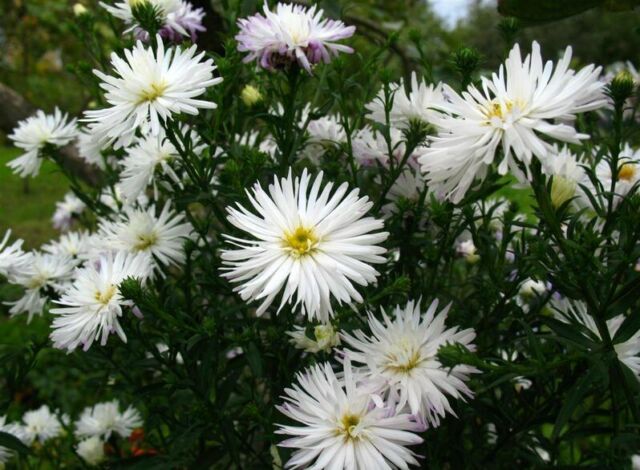

Avoid places where water is stagnant, because this is a place where pathogens accumulate. And where groundwater flows, there is too high humidity, which will provoke rotting of the root system.
Despite the fact that asters are not demanding on the composition of the soil, it is better to give preference to loamy, not heavy soils. They will be distinguished by good air permeability and the presence of essential nutrients that the plant needs.
Take into account the characteristics of the variety, for example, tall plants should not be planted in places where there are strong gusts of wind and drafts. They can break this culture.
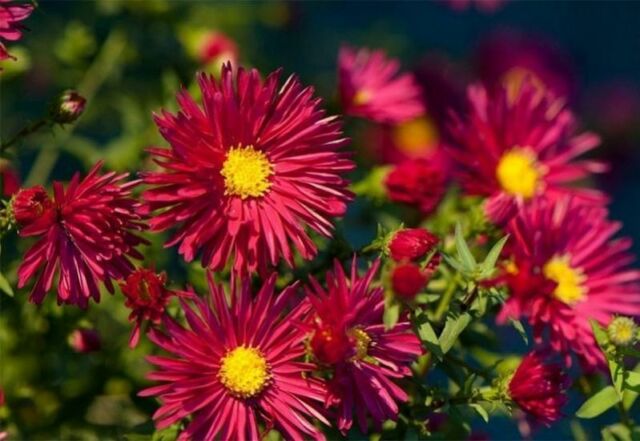

Asters are beautiful flowers and are prized for their ease of growing and ease of care. By combining various varieties, you will create a unique floral interior. After all, they can decorate sidewalk paths, paths, as well as a place near the facade of a house or plant it along a fence.
In addition, they stand perfectly in cut form. How nice it is to admire the bright, fluffy bouquet of flowers, with a light, enchanting aroma that will remind you of wonderful summer evenings on your favorite area.
Good landings and beautiful flowers!
Author of the publication
offline 8 months
Cuttings.
Propagation by cuttings is the most optimal breeding option for asters if you want the juveniles to inherit all the maternal characteristics. This method is available even for beginners, if, of course, you follow some rules.
Only healthy and strong cuttings are required to be cut.
When cutting young shoots into pieces, make sure that each petiole has 3 leaves.
Sections are subject to treatment with a preparation to stimulate root formation, for example, succinic acid.
Petioles are planted in a soil substrate, which includes turf, peat and sand.
In order for the petioles to take root faster, they must be covered with a film material.
Moistening of the soil is carried out moderately; strong drying and excess moisture should not be allowed.
The planted plants are ventilated daily - the film material is temporarily opened.
14-21 days after the rooting of the cuttings, the film is removed.
Adapted bushes are transplanted into the ground in the last summer days or in the first autumn month.


Queen of the autumn garden - astra
Just imagine that there are currently more than 600 types of asters. They include a huge variety of varieties that amaze even the most fastidious landscape designer with their beauty. Asters are unusual in that their inflorescences are all different, you can often confuse bushes with chrysanthemums, peonies, but there is another unique feature - shades, among which there is a variety of blue. It is quite rare among flowers of all kinds.
Asters are unpretentious, beautiful, accessible to everyone, can be grown both with seedlings and without them in all regions of our large country. What else do you need? Yes, it's just a little better to understand the varieties, because it is difficult for a beginner not to get confused in such an assortment. In this we will help you, of course, we cannot describe all 600 species, but we will tell you about those varieties that are most often planted by gardeners - the best and most beautiful. And as you could understand, today we will mainly talk about perennial asters.
Wintering
Perennials are frost resistant. They do not require any troublesome preparations for the winter period. They can handle it just fine.
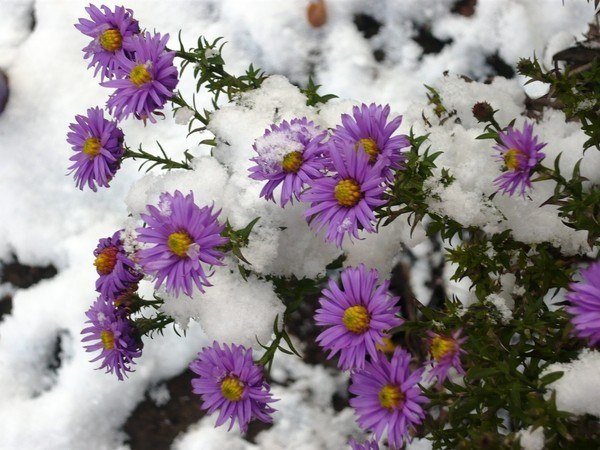

After the onset of the first night frosts, you need to cut off the entire upper part of the bush, leaving 4 cm stumps. As a rule, depending on the region, this time falls on October - November. Pruning is done in dry, not rainy weather.
Create a mulch layer with sawdust, dry leaves, or compost. In the spring it will also serve as a good fertilizer. If the shoots are young, you can additionally cover them with spruce legs or a mountain of dry leaves. This will help them not freeze until the snow cover appears.
Flowers safely endure winters, so do not worry about this autumn beauty.
New England and New Belgian
New Belgian and New England (American) are autumn varieties... They have a lot in common, however: American grows up to two meters, while Novobelgiskaya has an average height of about 1.5 meters.
Astra Marie Ballard
It belongs to tall varieties, it can grow up to 1 meter. The stems are strong and resilient, so no additional support is required. It is considered an early variety, since blooms in August and keeps color up to 60 days.
The inflorescences are large - from 5 to 8 centimeters. The color range is varied: from lavender to blue.
Perennial
All New Belgian are perennial flowers... All of them are divided into 2 subgroups: shrub and herbaceous, depending on the height of the plant.
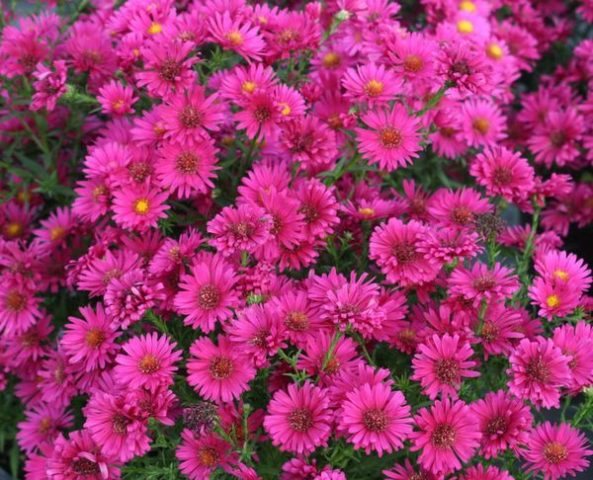

It doesn't matter which variety of New Belgian you choose - each of them is perennial
The most popular perennial varieties among florists include the following types:
New Belgian Mont Blanc... This is a tall plant up to 140 centimeters tall. Blooms from mid-September to mid-November. Terry inflorescences, white.
New Belgian Royal Ruby... Medium height with rich crimson inflorescences. Flowering time is from August to September. Frost-resistant grade.
New Belgian "White Lady"... It got its name for its small snow-white flowers. Blooms in late August. Frost resistant.
Autumn
There is no specific variety called "Autumn". This is a group of varieties that begin their flowering from the beginning of autumn. These varieties include the following New Belgian Asters:
- Sam Benham - this variety It ranked first among white-flowered asters. Plant height up to 1.5 meters. The stems are densely covered with leaves and many inflorescences. Flowering period: mid-September to mid-October.
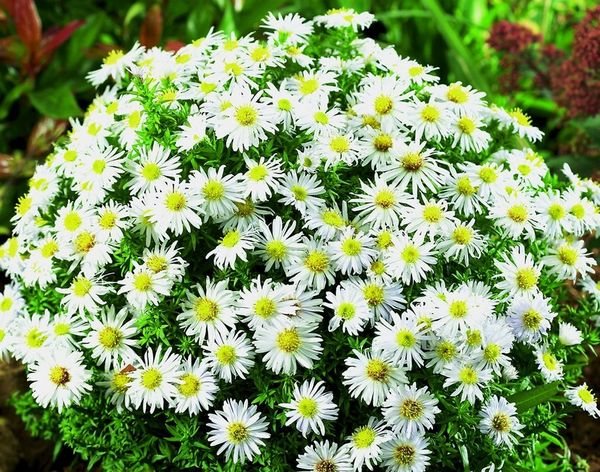

Unusual white appearance makes Benham look like chamomile
- Royal Blue is another tall plant with double flowers in a blue range. Blooms in September and lasts until the end of October.
- Sunset is a medium-sized bush of this variety and is densely covered with many small inflorescences of a pink-purple hue. It blooms from September with a duration of 30-35 days.
Photo of seeds
The best peony varieties
Bolero, Barbara, Blue Tower, Violetter red, Marshmallow, Apple blossom (king size)
High quality cut
Princess
Large terry
Yabluneva
Luxurious inflorescence
Beauty day pink
Pest control
Any beautiful bush can be attacked by harmful insects, and then this plant will wilt, which will ultimately lead to death. To prevent this from happening, in this case, you need to take immediate measures to eliminate them.
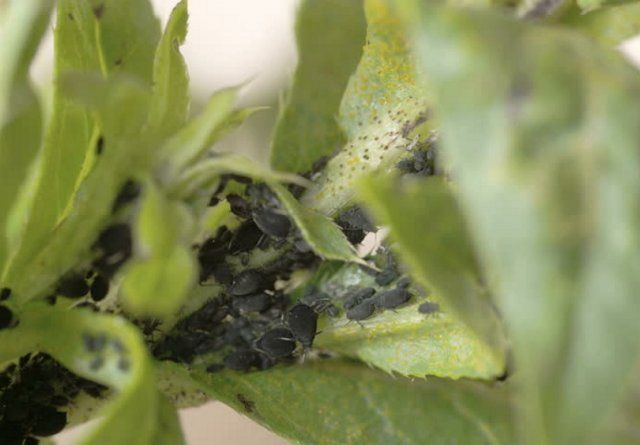

- Kidney aphids are common. It is dangerous in that it begins to destroy the buds, or young shoots of the flower. They begin to deform and eventually fall off. Effective against its chemical agent karbofos. For the complete destruction of the insect, it is necessary to spray it with a solution three times.
- The spider flare affects the foliage of the plant. They begin to change their color, wither, and then fall off. From the bottom of the leaf, you can see the appearance of a brown cobweb. Karbofos is also good for him. But you can also use the folk method. Take a piece of laundry soap, grate it and dilute it in one liter of warm water. Treat with this soap composition and this pest will be destroyed.
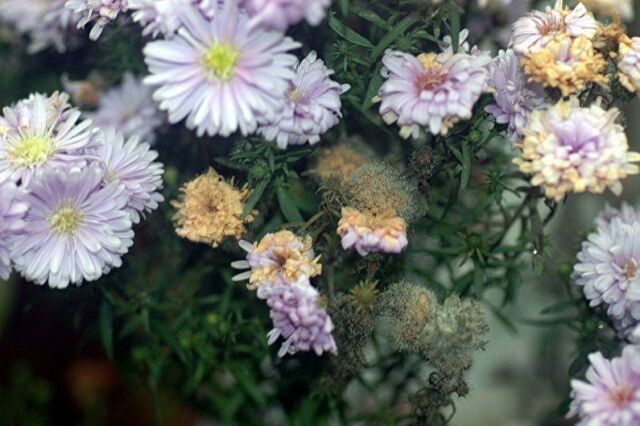

- Plowed slug. If you see slugs on a flower, this is an alarming sign. After all, he devours plants and flowers. It must be collected by hand from the bushes and burned outside the garden. For preventive measures, treat the soil with superphosphates or limestone.
- Thrips. Small insects no more than 2 mm, which are dangerous to the plant. They can be of different colors, black, white or reddish. Thrips feed on bush juices, moreover, they are carriers of various diseases and fungi. As a result of their attack, the foliage is covered with various spots of white and yellow, which grow over time. Before treatment with an insecticide solution, the deciduous part must be rinsed.
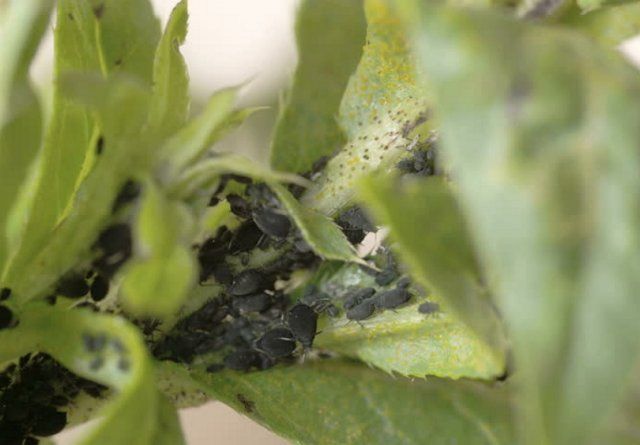

In order to reduce the risks of seeing harmful insects on your pets, it is necessary to take preventive measures.
- Periodically treat the soil with a fungicide solution. It is a universal remedy for many diseases.
- Keep distances when planting in order to protect neighboring plants in case of illness.
- While weeding the soil from the weeds and loosen it.
- Follow the recommendations when planting flowers. What soil does the plant like, the frequency of watering and top dressing.
And be sure to burn infected plants.
Content
- Listen to the article
- Description
- Growing Asters from Seeds Seeds
- When to sow
- Sowing seedlings
- When to plant
- How to care
- Post-flowering care
- Perennial asters
Perennial classification
The variety of varieties of perennial asters is so great that it is possible to create the most interesting compositions from this flower alone, in which the plants differ not only in appearance, but also in the timing of flowering.
Types of perennial asters, depending on the flowering time:
- Early varieties bloom at the end of May and continue to delight the eye until the last days of June (these varieties are also called spring varieties).
- Summer asters have an average flowering period - from July to the end of August.
- Late or autumn flowers open their buds with the arrival of September, and their flowering ends with severe frosts and snow.


Some experts share the types of perennial asters also depending on the height of the plants. It turns out three groups of varieties:
- A low-growing or border aster has a maximum height of 25-30 cm. This flower resembles a ground cover, therefore it is successfully used in the design of rockeries and alpine slides that are fashionable today.
- Garden asters have average parameters of bushes - about 40-70 cm. Most often, such a plant resembles a ball in its shape, the bushes look neat and elegant, they are in perfect harmony with other plants, they can frame hedges and garden paths.
- Perennial tall asters can have a maximum height of 150-160 cm. Such flowers are best used in the center of the flower bed: all season tall shrubs will delight with lush greenery, and closer to autumn they will bloom many variegated inflorescences.
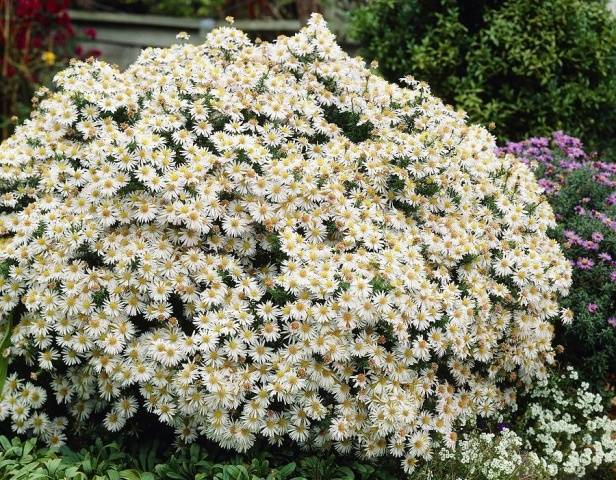

Prevention of diseases and harmful insects.
The variety has a high immunity to common diseases, but if you take care of flowers poorly, they can get sick with powdery mildew or fusarium. When the first symptoms of the disease appear, the removal of the infected fragments and their destruction is required, the bushes are treated with medicines against the fungus or Bordeaux mixture.
The flowers can also be attacked by harmful insects, for example, spider mites, caterpillars, slugs. Prevention and treatment are carried out with various drugs or folk remedies, for example, ash or soap solution. The best preventive measure is to provide favorable conditions for the life of flowers. Then you won't have to heal.
Features of the
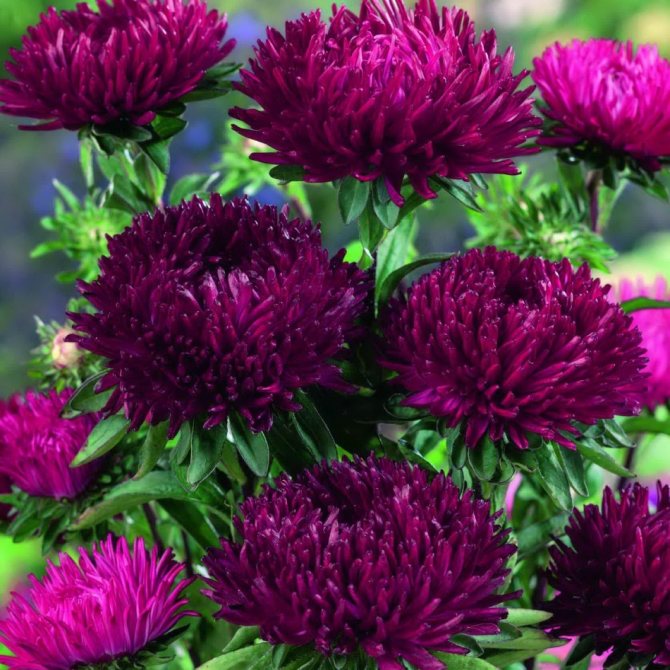

Aster is not only beautiful, but also a strong plant.
She is one of the few that can bloom at sub-zero temperatures.... For her colors, the critical mark on the thermometer will be the temperature below -7.
Its seeds are highly germinating. They can be stored for a long time, while they do not require special conditions.
Astra quickly takes root. It can be transplanted even during active flowering. She quickly rebuilds her root system.
back to menu ↑
See also: Mulberry: description of 3 popular species, growing in the middle lane, reproduction and care, useful properties (50+ Photos & Videos) + Reviews
Cooking place


Like any plant, before planting asters, you need to choose and prepare a comfortable place for them.
back to menu ↑
Read also: Aquilegia: 25 most common species, planting, care and reproduction rules (70+ Photos & Videos) + Reviews
Lighting
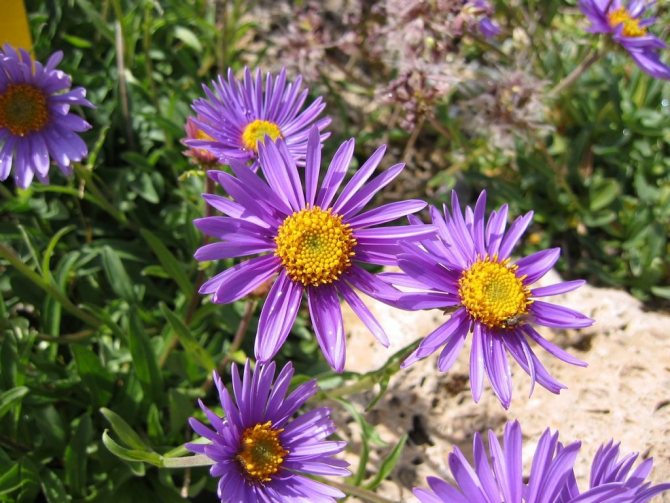

Places favored by sunlight are favorable for asters.
Its flowers and foliage are not afraid of direct rays. However, it can grow in partial shade. This will affect flowering. It will become less abundant.
back to menu ↑
See also: Alyssum: species and varieties of plants, sowing seeds in open ground and caring for a rainbow carpet on the site (130 Photos) + Reviews
The soil
Aster bushes need slightly acidic soil. It should be sandy loam or loamy. These flowers do not like to grow where tulips or gladioli were previously planted, but after calendula it grows very well.
The plant does not need a very moist soil. And stagnant water will lead to his death. Therefore, at high humidity, it is necessary to remove the top layer and lay a drainage layer under it. You can use gravel for this.
back to menu ↑
See also: Bellflower - natural beauty in your flower bed: description, varieties, planting and care, growing from seeds (50 Photos & Videos) + Reviews
What is the American aster?
American or New England aster is an incredibly beautiful shrub that has impressive size and a fairly spreading "crown". Average figures may vary, but it is believed that it is the shrubs of this type of aster that may well exceed a height of 2 meters. In addition to its impressive size in height, it should be noted that the shrub grows proportional, since the diameter can reach indicators close to a meter. The foliage has an elongated lanceolate shape, as well as a rich color. Flowering is the main "feature" of the American aster, because the flowers are not large, and reach only a few centimeters in diameter, which gather in fairly large inflorescences, turning the shrub into a bright blooming ball. The approximate number of inflorescences on each bush is equated to 30, but there are discrepancies depending on the variety. Flowers are considered reed. The color of the American aster is its main weapon, because almost all delicate and pastel shades are found in the inflorescences of this bush beauty. Pink and purple, purple and violet, white and blue, yellow and slightly red, snow-white and light burgundy - a wide variety of American aster beauty
Features and main advantages of the American aster
Each plant has a number of points that not only distinguish it, but also extol it among its relatives or nearby growing ornamental plants, so the following unique and typical features of the American aster should be known to everyone who would like to get this unusual type of aster on their site.
- Impressively huge size.The flowering bush of the American aster is capable of covering many annuals and perennials growing in a flower bed. Three-meter living fences made of asters, specially planted near the hedge, are decorated with a large number of flowering buds and resemble a cascading multicolored waterfall - this is what you can look at forever, because you cannot find such a living and flowering hedge.
- Various colors of inflorescences.On one adult bush of American asters, you can observe multi-colored small baskets, collected in shields and clusters of complex inflorescences. The delicate and pure beauty of shades from dark purple to bright white is simply enchanting. It is such a picture that is a true decoration, which can be used not only as a decor, but also easily become an element of landscape design.
- Unusual form of inflorescences for asters.Pink, lilac, lilac, cherry, red and white flower buds with reed petals, yellow or red-brown, tubular centers, are located on branching shoots in multi-colored clusters, collected in several paniculate inflorescences. A wide range and riot of colors not only attracts attention, but also provokes the creation of original bouquet compositions.
- Long flowering period of buds.The first flowers on a bushy perennial appear in early June or August, depending on the variety and region of cultivation, and the rapid flowering continues until November - this is the main trump card of the plant, because all summer you can enjoy a chic flower bed, which is decorated with American aster of different shades in combined with a variety of "neighbors".
- Late flowering.The American aster plant is characterized by late flowering. When many flowering specimens have shed their foliage and dried buds, American aster not only continues to bloom, but also releases new buds until the first frost occurs. At the end of October, on a perennial bush, you can count up to 40 opened inflorescences.
- Frost resistance is the strong point of the plant.Adult bushes of the American aster are completely safe from fluctuations in temperature. With a morning frost of 5 degrees, the plant feels great. It is this factor that allows you to maintain high-quality flowering until mid-autumn.
- Does not tolerate thickening of plantings.American aster is a plant of impressive size, and develops well, builds up green mass and blooms in spacious flower beds, where there is no excess vegetation, but a lot of space, light and heat. Before and during flowering, planting must be thinned out by cutting off weak branches and removing too thickened areas. Tightness in the garden is the first reason for the poor development and flowering of bush asters.
Review of the best varieties
The variety of New England aster varieties is pleasantly impressive. Among them, each of the gardeners will find the most beloved ones. Of course, there are a number of varieties that are most popular, and the description of which is best known.
- Barr`s Blue It is a medium-sized bush with a height of about 120-125 cm. As the name implies, its flowers are bluish with a yellow core. Flowering occurs in the first autumn months. Differs in its endurance. It is recommended to plant about 5 bushes per square meter.
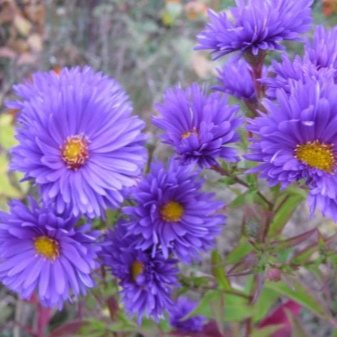

- Bars Pink it grows on average up to 100 centimeters, and the maximum height is 150 centimeters. The color of the flowers ranges from pink to lilac. Active flowering occurs in late September - early October. The diameter of the inflorescences is 4 cm, and they themselves are collected in the form of brushes.
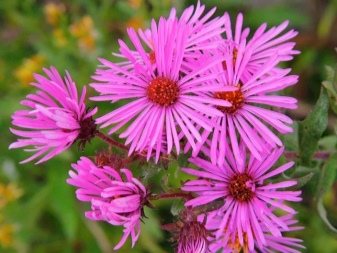

- Purple Dome is a stunted representative of the American aster. The average height of the bushes is 40-50 cm. The inflorescences are purple in color with a dark tint. The diameter of one flower can reach 3.5-8 centimeters. Flowering begins in August and lasts until the end of September. Can be grown in areas with severe frost and acidic soils.


- Browmann - perennial aster with baskets of lilac and purple shades. Plant height reaches 120 centimeters. The bush is distinguished by branching and inflorescences with a diameter of 4 cm. Abundant flowering begins in September and can last until the end of autumn. Great for creating bouquets.
- Andenken an Alma Poetschke well suited for open ground in areas where in winter the temperature rarely drops below minus 10 degrees. The flowers are bright red with a salmon tint. Active flowering occurs in the first two autumn months. The height of the bushes reaches an average of 100-120 centimeters.
- Constance it is distinguished by expressive lilac flowers up to 8 centimeters in diameter. Aster can grow in one place for 5 years. The height of the bushes reaches 150-180 cm. They can grow in partial shade. The flowering time is approximately 30 days or more.

